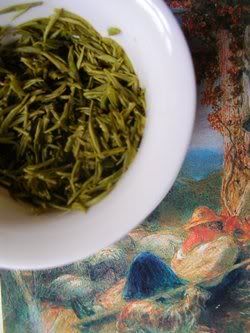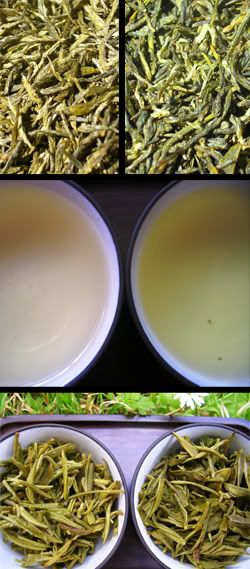 This tea taught me a great deal. Brewing many types of lucha is easy, as it can be fairly forgiving. Xinyang Maojian ["furry tip" from the Xinyang region] is not one of these teas - it is very unforgiving.
This tea taught me a great deal. Brewing many types of lucha is easy, as it can be fairly forgiving. Xinyang Maojian ["furry tip" from the Xinyang region] is not one of these teas - it is very unforgiving.Getting the best out of this tea required experimentation, but the results were rewarding. In its fickle nature, but not in its flavour, it reminds me of many Japanese teas that I have ruined in the past.
First of all, why should we bother? The answer is this tea's status as one of the Shi Da Ming Cha [ten great teas]. Arguable and indefinite as this list might be, that it always contains Xinyang Maojian is testament to its perceived quality in the eyes of tradition.
As regular readers might recall, Lei is from Xinyang territory (in central Henan Province), and the majority of her local tea-shop is occupied by varying grades of this leaf. For the purposes of education, we compared a low, "daily" grade (25 RMB/50g - approx. £1.50 or $3) to the very highest grade (60 RMB/50g) - both of which were designated "organic" by the shop owner. "Don't be misled by the apparently low prices - this is very expensive tea for Henan."
Lei recounts her happiness of the time she was browsing the wares in the tea-shop when a local farmer-worker [effectively what amounts to a "peasant" in the difficult economy of rural China] came in to buy Xinyang Maojian. She was deeply impressed that appreciation of good tea cuts across all social classes. I often remind myself what low calibre of tea the general populace of England will accept, despite their relative affluence, and look on the farmer-worker with a similar degree of sincere respect. "Money can't buy good taste", they say.
Brita-filtered tap water @ 70C in 9cl gaiwan; 1 rinse
In the photographs, the top grade and bottom grade appear on the left and right, respectively.
 Dry leaf:
Dry leaf:The top grade is all tips, and is a beautiful, gentle green. The low grade is cut with some darker, larger leaves, and contains more fragments. The illustration shows a yellowish tint to the top grade, which is misleading.
Bottom Grade:
This tea is very easy to brew. Only a small number of leaves are required (~4-5g), and the flavour is the pleasantly sour, grassy character of some Xinyang Maojian. The soup is typically cloudy. It is very hard to overbrew or underbrew, and a generally pleasant flavour is obtained no matter what.
The shopkeeper brewed this in the manner that the majority of Chinese drink their tea: a small number of lucha leaves, in a glass of hot water.
Top Grade:
This was the challenge, and the education.
Brewed "conventionally", in my normal manner (~5g leaf in the gaiwan, with 80C water), the result was pure ku, with almost no flavour. It was deeply, sincerely unpleasant. This can be seen in the photograph, where the colour of the soup is a light brown, without much appeal. Well can be imagined the character of the pinmingbei [tasting cup].
Alerted by the overwhelming ku, we tried again with this tea during another sitting, using fewer leaves (~3g). The result was similarly unpleasant, and lacking in any charm whatsoever.
For the third sitting, I treated it as a young shengpu: lots of leaves (~8-9g), with as short an infusion as I could (~3 seconds, after putting down the kettle, and putting the hulu [gourd filter] onto the gongdaobei). I used cooler water (70C).
The result was exceptionally delicious. The ku had gone, and a beautifully rich flavour of flowers and wild grasses filled the mouth and nose. "This is amazing, it is just right. It is like a rich and delicious food, cooked perfectly."
Suddenly, finally, the mystery disappeared, and the quality of the leaves shone through. It seems that good Xinyang Maojian is worth the effort, as it is disjoint in its character to many of the other lucha that we have previously enjoyed.
Overall:
The low grade was a fairly generic, grassy affair. The true charm came from the top grade, which filled the mouth with sumptuously rich flavours, and evoked an image of the flowering fields of a warm English summer, such as we are currently experiencing.
I am grateful both for the opportunity to taste a good example of this genre, but also in evaluating the differences between the top and bottom grades, and in learning (with some necessary persistence) how to coax the hidden delights out of the expensive leaf.

I was going to say.... 25RMB/50G is still pretty expensive tea... not what I'd call everyday
ReplyDeleteThe scale of the economies requires constant readjustment whenever dealing with Chinese prices - even variety between Chinese cities can be very significant, as you know.
ReplyDeleteA tricky one - especially when the exchange rate from RMB into sterling is a prime number (£7 = 100 RMB), making the internal computation of prices a tortuous affair!
Toodlepip,
Hobbes